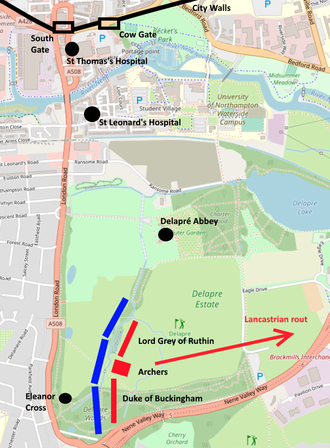Year 1460 (MCDLX) was a leap year starting on Tuesday of the Julian calendar, the 1460th year of the Common Era (CE) and Anno Domini (AD) designations, the 460th year of the 2nd millennium, the 60th year of the 15th century, and the 1st year of the 1460s decade.

Edward IV was King of England from 4 March 1461 to 3 October 1470, then again from 11 April 1471 until his death in 1483. He was a central figure in the Wars of the Roses, a series of civil wars in England fought between the Yorkist and Lancastrian factions between 1455 and 1487.

Richard Neville, 16th Earl of Warwick, 6th Earl of Salisbury, known as Warwick the Kingmaker, was an English nobleman, administrator, landowner of the House of Neville fortune and military commander. The eldest son of Richard Neville, 5th Earl of Salisbury, he became Earl of Warwick through marriage, and was the wealthiest and most powerful English peer of his age, with political connections that went beyond the country's borders. One of the leaders in the Wars of the Roses, originally on the Yorkist side but later switching to the Lancastrian side, he was instrumental in the deposition of two kings, which led to his epithet of "Kingmaker".
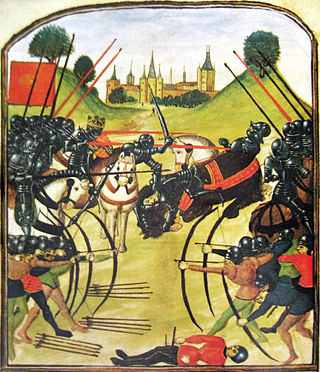
The Battle of Tewkesbury, which took place on 4 May 1471, was one of the most decisive battles of the Wars of the Roses in England.

The Battle of Wakefield took place in Sandal Magna near Wakefield in northern England, on 30 December 1460. It was a major battle of the Wars of the Roses. The opposing forces were an army led by nobles loyal to the captive King Henry VI of the House of Lancaster and his Queen Margaret of Anjou on one side, and the army of Richard, Duke of York, the rival claimant to the throne, on the other.

The Battle of Towton took place on 29 March 1461 during the Wars of the Roses, near Towton in North Yorkshire, and "has the dubious distinction of being probably the largest and bloodiest battle on English soil". Fought for ten hours between an estimated 50,000 soldiers in a snowstorm on Palm Sunday, the Yorkist army achieved a decisive victory over their Lancastrian opponents. As a result, Edward IV deposed the Lancastrian Henry VI and secured the English throne.
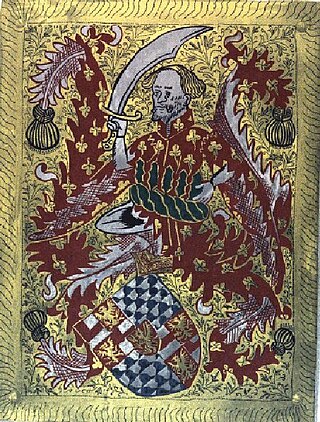
Richard Woodville, 1st Earl Rivers, also Wydeville, was the father of Elizabeth Woodville and father-in-law of Edward IV.
John Neville, 1st Marquess of Montagu was a major magnate of fifteenth-century England. He was a younger son of Richard Neville, 5th Earl of Salisbury, and the younger brother of Richard Neville, Earl of Warwick, the "Kingmaker".
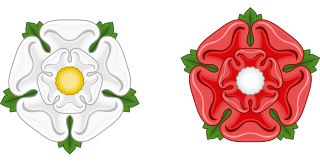
The Battle of Mortimer's Cross was fought on 2 February 1461 near Kingsland, Herefordshire, not far from the Welsh border. It was a major battle of the Wars of the Roses. The opposing forces were an army led by Jasper Tudor and his father, Owen Tudor, and other nobles loyal to King Henry VI of the House of Lancaster, his wife, Margaret of Anjou, and their seven-year-old son, Edward, Prince of Wales, on one side, and the army of Edward, Earl of March. Some sources say it was fought on 3 February, and the exact location has been the subject of some speculation.

Henry Beaufort, 3rd Duke of Somerset was an important Lancastrian military commander during the English Wars of the Roses. He is sometimes numbered the 2nd Duke of Somerset, because the title was re-created for his father after his uncle died. He also held the subsidiary titles of 5th Earl of Somerset, 2nd Marquess of Dorset and 2nd Earl of Dorset.

The Rout of Ludford Bridge was a largely bloodless confrontation fought in the early years of the Wars of the Roses. It took place on 12 October 1459, and resulted in a setback for the Yorkists. Although this seemed to be a triumph for the rival Lancastrians at the time, they had thrown away their advantage within six months.

The Battle of Sandwich was a naval skirmish off the town of Sandwich on the 15 January 1460 during the Wars of the Roses. In it, Sir John Dynham, Sir John Wenlock, and the Earl of Warwick, Captain of Calais, on the Yorkist side, defeated a Lancastrian fleet and captured several of its ships. Little evidence and few details of the battle survive.
Thomas Fauconberg or Thomas Neville, sometimes called Thomas the Bastard, or the Bastard of Fauconberg, was the natural son of William Neville, Lord Fauconberg, who was a leading commander in the Hundred Years' War and, until joining his cousin, Richard Neville in rebellion on the Lancastrian side against another cousin, Edward IV, served on the Yorkist side in the Wars of the Roses.
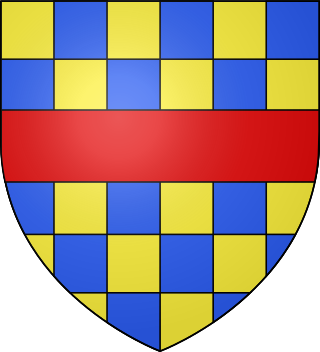
John Clifford, 9th Baron Clifford, 9th Lord of Skipton was a Lancastrian military leader during the Wars of the Roses in England. The Clifford family was one of the most prominent families among the northern English nobility of the fifteenth century, and by the marriages of his sisters, John Clifford had links to some very important families of the time, including the earls of Devon. He was orphaned at twenty years of age when his father was slain by partisans of the House of York at the first battle of the Wars of the Roses, the Battle of St Albans in 1455. It was probably as a result of his father's death there that Clifford became one of the strongest supporters of Margaret of Anjou, wife of King Henry VI, who ended up as effective leader of the Lancastrian faction.
Events from the 1450s in England.
Events from the 1460s in England.

Sir Humphrey Stafford, 1st Earl of Devon, 1st Baron Stafford of Southwick was a dominant magnate in South West England in the mid-15th century, and a participant in the Wars of the Roses. A distant relative of the Earls of Stafford, Humphrey Stafford became the greatest landowner in the county of Dorset through fortunes of inheritance. Later, Stafford was one of several men promoted rapidly through the nobility by King Edward IV, to fill the power vacuum left by dead or forfeit Lancastrians. In the West Country it was particularly the forfeitures of the Lancastrian Courtenay family that benefited Stafford. In 1469 he received the Courtenay title of Earl of Devon.

The Wars of the Roses, known at the time and in following centuries as the Civil Wars, were a series of civil wars fought over control of the English throne from 1455 to 1487. The wars were fought between supporters of the House of Lancaster and House of York, two rival cadet branches of the royal House of Plantagenet. The conflict resulted in the end of Lancaster's male line in 1471, leaving the Tudor family to inherit their claim to the throne through the female line. Conflict was largely brought to an end upon the union of the two houses through marriage, creating the Tudor dynasty that would subsequently rule England.

The Second Battle of St Albans was fought on 17 February 1461 during the Wars of the Roses in St Albans, Hertfordshire, England.

The siege of the Tower of London was an episode of the Wars of the Roses, in which adherents of the rival Plantagenet houses of Lancaster and York were pitted against each other. In June 1460, several Yorkist nobles, who had unsuccessfully rebelled against King Henry VI the year before and had fled to Calais, invaded the south east of England at Sandwich. They enjoyed widespread support through popular discontent with the ruling court among the populace of Kent and the merchants of London, and were greeted by enthusiastic crowds when they entered London on 2 July.


